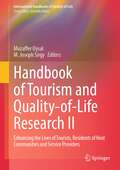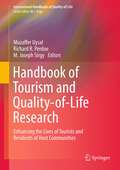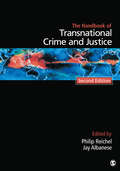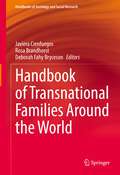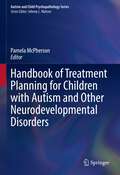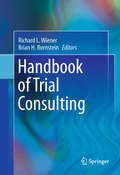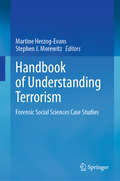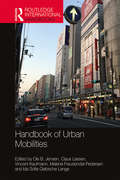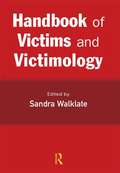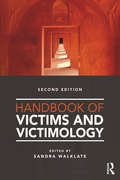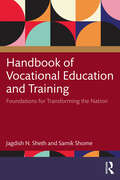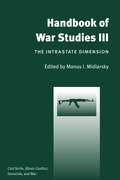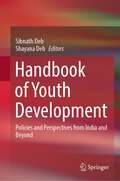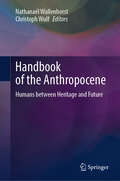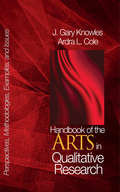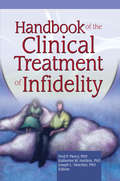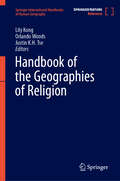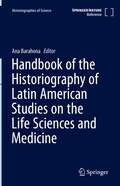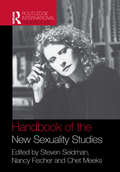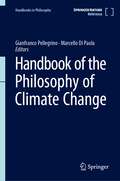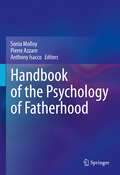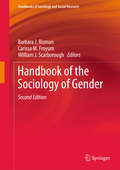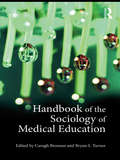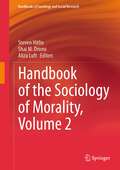- Table View
- List View
Handbook of Tourism and Quality-of-Life Research II: Enhancing the Lives of Tourists, Residents of Host Communities and Service Providers (International Handbooks of Quality-of-Life)
by Muzaffer Uysal M. Joseph SirgyThe second volume of this handbook develops on and extends the discussion in the successful first volume, published in 2012. This is a timely addition to the literature, drawing on the momentum that quality of life (QOL) research in tourism has gained in the 21st century and on the boom in the tourism industry itself. It focuses on four areas of growth in QOL research in the recent past: (1) travelers/tourists, (2) host communities, (3) service providers, and (4) the role of technology. The handbook helps management of tourism firms and policy makers develop specific policies and programs to ensure the most positive impact of tourism on tourists, host communities, and service providers. The comprehensive coverage of topics in this handbook makes it a state-of-the-art reference. Academics interested in QOL research in travel and tourism, tourism practitioners interested in applying the science of QOL in the tourism industry, as well as policy makers involved in regulating the industry will view the handbook as indispensable source of recent research.
Handbook of Tourism and Quality-of-Life Research: Enhancing the Lives of Tourists and Residents of Host Communities
by Muzaffer Uysal M. Joseph Sirgy Richard PerdueQuality of life (QOL) research in tourism has gained much momentum over the last two decades. Academics working in this area research issues related to tourists and host communities. Practitioners are becoming increasingly interested in understanding the science that allows them to develop better marketing and managerial programs designed to enhance the quality of life of tourists. Tourism bureaus and government agencies are increasingly interested in issues of sustainable tourism, specifically in understanding and measuring the impact of tourism on the quality of life of the residents of the host communities. This handbook covers all relevant topics and is divided into two parts: research relating to travelers/tourists, and research relating to the residents of host communities. It is the only state-of-the-art reference book in its field and will prove invaluable to academics interested in QOL research, as well as tourism practitioners interested in applying the science of QOL in the tourism industry.
Handbook of Transnational Crime and Justice
by Jay S. Albanese Philip L. ReichelTransnational crime and justice will characterize the 21st century in same way that traditional street crimes dominated the 20th century. In the Handbook of Transnational Crime and Justice, Philip Reichel and Jay Albanese bring together top scholars from around the world to offer perspectives on the laws, crimes, and criminal justice responses to transnational crime. This concise, reader-friendly handbook is organized logically around four major themes: the problem of transnational crime; analysis of specific transnational crimes; approaches to its control; and regional geographical analyses. Each comprehensive chapter is designed to be explored as a stand-alone topic, making this handbook an important textbook and reference tool for students and practitioners alike.
Handbook of Transnational Families Around the World (Handbooks of Sociology and Social Research)
by Deborah Fahy Bryceson Javiera Cienfuegos Rosa BrandhorstThis handbook compiles the most up-to-date research on transnational families. It employs a dialogue between classical approaches and cutting-edge directions in transnational family research to identify continuities and changes in terms of socioeconomic disparities and actors, and to analyze coexistence. Further, the volume adopts a twofold global and international comparative perspective. On the one hand, it focuses on different migratory flows around the world and describes their entangled logics; on the other, it is written by an international group of contributors, with a diverse range of professional backgrounds. Their contributions are based on sound empirical research, and explore geographical regions around the world. The handbook presents different thematic perspectives on transnational families, including an analytical focus on gender, global sociodemographic inequalities, power asymmetries, and border- and mobility regimes, as well as the organization of transnational care, transnational fatherhood, ageing, family reunions and return. It also includes a variety of methodological approaches to transnational family research, ranging from ethnography, biographical research, and life-course methods, to multi-sited approaches and quantitative surveys. Investigating an emergent debate, it sheds new light on migratory fluxes, their common and specific determinants, the types of actors involved, and ways to empirically and methodologically approach them. This is a must-read reference for social scientists interested in family research, migration, and gender studies. Chapter 7 is available open access under a Creative Commons Attribution 4.0 International License via link.springer.com.
Handbook of Treatment Planning for Children with Autism and Other Neurodevelopmental Disorders (Autism and Child Psychopathology Series)
by Pamela McPhersonThis handbook addresses treatment planning for children with autism spectrum disorder (ASD) and other neurodevelopmental disabilities (NDDs) using a medical home perspective. It examines the medical home model, which has been promoted as the standard of care by the American Academy of Pediatrics since 2002, emphasizing collaboration between patients, families, and providers to optimize care. The handbook addresses treatment planning, including the coordination of the care provided by multiple specialists with a clear, shared vision for maximizing each child’s potential.Key areas of coverage include:· Elements of treatment planning, history of the medical home model, documentation, and strategies to facilitate communication.· Goals of treatment from the perspectives of the family, person served, care providers, and fiscal and regulatory bodies.· Role of each specialist, highlighting the most common conditions experienced by children with ASD and other NDD with expectations for assessment and treatment.· Detailed recommendations for making referrals and assisting the child and family in preparing for appointments.The Handbook of Treatment Planning for Children with Autism Spectrum Disorder and Other Neurodevelopmental Disabilities is a must-have resource for researchers, professors, and graduate students as well as clinicians, therapists, and other professionals across such interrelated disciplines as clinical child, school, and developmental psychology, child and adolescent psychiatry, social work, rehabilitation medicine/therapy, pediatrics, and special education.
Handbook of Trial Consulting
by Brian H. Bornstein Richard L. WienerThis volume will be a handbook that treats trial consulting as applied psychology. The purpose of the volume will be to collect the viewpoints of leaders in the field of psychology and law who apply the discipline's theoretical models, methods, and ethics to assist litigators to try cases in the most effective way possible. As a whole, the collection of chapters will describe the theory, business, and mechanics of trial consulting for those interested in learning and practicing the profession. However, it will do so from the perspective of organized theories of jury-decision making. In other words, the work of juror researchers will inform the recommendations and suggestions in the handbook. The volume consists of six sections, each pertaining to a different topic. Multiple chapters with different authors will cover each topic. The topics and corresponding seven sections will be 1) An Introduction to the Theory and Psychology of Jury Decision-Making, 2) Applied Research Methodologies for Trial Consultants, 3) Education and Ethical Considerations for Trial Consultants, 4) Preparing and Cross Examining Witnesses, 5) Technology and Demonstrative Evidence at Trial, and 6) Special Topics in Trial Consulting. Each section will begin with the editors' short introduction reviewing that section and explaining its goals, objectives, and content. Separate individuals, recognized as leaders in their areas will write the remaining chapters in each section. These individuals come from the fields of both psychology and law, and represent viewpoints on these topics from a practice-oriented perspective, but a perspective that is emerges from research results. They are affiliated with a number of academic institutions, including University of Nebraska, John Jay College of Criminal Justice, University of Texas, University of Chicago Simon Fraser University, and private law firms.
Handbook of Understanding Terrorism: Forensic Social Sciences Case Studies
by Stephen J. Morewitz Martine Herzog-EvansThis book examines common theoretical conceptualization of terrorism, including all the following dimensions: Macro-criminological theories Psycho-criminological models of aggression Psycho-criminological models of risk and need (RNR) Psychopathology Social psychology, particularly in the areas of intergroup relations, identity, need for closure, and, the quest for significance Ideological and religious passions and extremism International in scope, each chapter draws on a combination of these frameworks, exemplified in a collection of case series and studies, to help students, practitioners, and researchers better understand these phenomena.
Handbook of Urban Mobilities (Routledge International Handbooks)
by Ole B. JensenThis book offers the reader a comprehensive understanding and the multitude of methods utilized in the research of urban mobilities with cities and ‘the urban’ as its pivotal axis. It covers theories and concepts for scholars and researchers to understand, observe and analyse the world of urban mobilities. The Handbook of Urban Mobilities facilitates the understanding of urban mobilities within a historic conscience of societal transformation. It explores key concepts and theories within the ‘mobilities turn’ with a particular urban framework, as well as the methods and tools at play when empirical, urban mobilities research is undertaken. This book also explores the urban mobilities practices related to commutes; particular modes of moving; the exploration of everyday life and embodied practices as they manifest themselves within urban mobilities; and the themes of power, conflict, and social exclusion. A discussion of urban planning, public control, and governance is also undertaken in the book, wherein the themes of infrastructures, technologies and design are duly considered. With chapters written in an accessible style, this handbook carries timely contributions within the contemporary state of the art of urban mobilities research. It will thus be useful for academics and students of graduate programmes and post-graduate studies within disciplines such as urban geography, political science, sociology, anthropology, urban planning, traffic and transportation planning, and architecture and urban design.
Handbook of Victims and Victimology
by Sandra WalklateThe study of criminal victimisation has developed to the stage where by victimology is now regarded as a central component to the study of crime and criminology. This focus of concern has been matched by the growth and development of support services for the victim of crime alongside increasing political concern with similar issues. The central purpose of this book is to bring together leading scholars to produce an authoritative handbook on victims and victimology that gives due consideration to these developments. It will be concerned to reflect contemporary academic, policy, and political debates on the nature, extent and impact of criminal victimisation and policy responses to it. This book provides a overview of the importance of the role of the victim in the criminal justice system, with an analysis of the different theoretical perspectives within victimology. explores the relationship between victimisation and feminism with particular focus on domestic and sexual violence. analyses criminal justice policy and service delivery in relation to victims of crime, looking at developments within the UK and international perspectives. This handbook will be fundamental reading for students and academics studying victims and victimology and an essential reference tool for those working within the victim support environment.
Handbook of Victims and Victimology
by Sandra WalklateThis second edition of the Handbook of Victims and Victimology presents a comprehensively revised and updated set of essays, bringing together internationally recognised scholars and practitioners to offer substantial research informed overviews within their specialist fields of investigation. This handbook is divided into five parts, with each part addressing a different theme within victimology: Part I offers a scene-setting exploration of new developments in the field, enduring issues that remain relatively unchanged and the gaps and traps within the contemporary victimological agenda Part II examines of the complex dimensions to victim experiences as structured by gender, age, ethnicity, sexuality and intersectionality Part III reflects on the problems and possibilities of formulating policy responses in the light of the changing appreciation of the nature and extent of victimhood Part IV focused on the value of a comparative lens and the problems and possibilities of victim policies when seen through this lens, explored along three geographical axes: Europe, Australia and Asia Part V considers other ways of thinking about who counts as a victim and what counts as victimhood and extends the boundaries of the victimological imagination outward Building on the success of the previous edition, this book provides an international focus on cutting-edge issues in the field of victimology. Including brand new chapters on intersectionality, child victims, sexuality, hate crime and crimes of the powerful, this handbook is essential reading for students and academics studying victims and victimology and an essential reference tool for those working within the victim support environment.
Handbook of Vocational Education and Training: Foundations for Transforming the Nation
by Jagdish N. Sheth Samik ShomeVocational education and training (VET) are major stepping stones in the development journey of any nation. A carefully structured and implemented VET system ensures skill development and equips the existing and prospective workforce with the necessary technical proficiency, thereby reducing unemployment and increasing productivity. This handbook is designed to provide the readers with a comprehensive understanding of the ways in which VET has been implemented in both highly developed and developing countries around the globe, including Germany, Japan, China, India, and countries in Africa and Latin America, among others. It looks at how VET plays a crucial role in empowering a nation, acts as a comparative advantage, and contributes to nation-building. In the process, it highlights the best practices and fallacies related to VET and showcases how effective vocational training can allow countries to confront existing deficits in employment and decent work. This detailed handbook will be of interest to policymakers, government officials, and corporate executives working in education, education policy, curriculum, teaching and learning, adult education and lifelong learning, and classroom practice. It will also be valuable to technical education students and those working with executive training programmes, public sector enterprises and NGOs related to VET.
Handbook of War Studies III: The Intrastate Dimension
by Manus I. MidlarskyHandbook of War Studies III is a follow-up to Handbook of War Studies I (1993) and II (2000). This new volume collects original work from leading international relations scholars on domestic strife, ethnic conflict, genocide, and other timely topics. Special attention is given to civil war, which has become one of the dominant forms - if not the dominant form - of conflict in the world today.
Handbook of Youth Development: Policies and Perspectives from India and Beyond
by Sibnath Deb Shayana DebThis handbook provides a comprehensive overview of youth development, including theories and applications across different countries, namely India, the UK, and Australia. It presents the status of youth and their role in society, their education, and their career perspectives. The focus is on developing youth's internal abilities by providing a creative and supportive environment through appropriate mentorship and encouragement. It discusses a wide range of contemporary and relevant issues relating to holistic career growth of youth, whereby youth work is recognized as a profession. Academicians from various disciplinary backgrounds offer conceptual and methodological perspectives. Chapters into five themes focus on a balance between developing stable, protective factors for mental health, and positive youth development to ensure appropriate cognitive, social, emotional, and behavioral skills needed to thrive in an evolving world. It discusses the status of the youth in terms of digital competency, engagement of youth in sports, teaching, political process, and community development activities in the present and rapidly altering world scenario. The book also discusses the role of institution-based family counseling for healthy youth development. Given its comprehensive coverage, the handbook is an essential resource for a broad audience of youth researchers, practitioners and policymakers of population sciences, childhood and youth studies, development studies, and psychology.
Handbook of the Anthropocene: Humans between Heritage and Future
by Christoph Wulf Nathanaël WallenhorstThis Handbook is a collection of contributions of more than 300 researchers who have worked to grasp the Anthropocene, this new geological epoch characterised by a modification of the conditions of habitability of the Earth for all living things, in its biogeophysical and socio-political reality. These researchers also sought to define a historical and prospective anthropology that integrates social, economic, cultural and political issues as well as, of course, environmental ones. What are the anthropological changes needed to ensure that our human adventure will be able to continue in the Anthropocene? And what are the educational and political issues involved?Anthropocene is fast becoming a widely-used term, but thus far, there been no reference work explaining the thoughts of the greatest experts of the present day on this subject (at the intersection of biogeophysical and socio-political knowledge). A scientific and political concept (but which is also the conceptual vehicle for conveying the scientific community's sense of concern), this complex term is explained by international experts as they reflect on scientific arguments taking place in earth system science, the social sciences and the humanities. What these researchers from different disciplines have in common is a healthy concern for the future and how to prepare for it in the Anthropocene and also the identification of possible anthropological changes. This Handbook encourages readers to immerse themselves in reflections on the human adventure through descriptions of our differing heritages and the future that is in the process of being written.
Handbook of the Arts in Qualitative Research: Perspectives, Methodologies, Examples, and Issues
by J Knowles Professor Ardra L. Cole"This work's quality, diversity, and breadth of coverage make it a valuable resource for collections concerned with qualitative research in a broad range of disciplines. Highly recommended." —G.R. Walden, CHOICEThe Handbook of the Arts in Qualitative Inquiry: Perspectives, Methodologies, Examples, and Issues represents an unfolding and expanding orientation to qualitative social science research that draws inspiration, concepts, processes, and representational forms from the arts. In this defining work, J. Gary Knowles and Ardra L. Cole bring together the top scholars in qualitative methods to provide a comprehensive overview of the past, present, and future of arts-based research. This Handbook provides an accessible and stimulating collection of theoretical arguments and illustrative examples that delineate the role of the arts in qualitative social science research. Key Features Defines and explores the role of the arts in qualitative social science research: The Handbook presents an analysis of classic and emerging methodologies and approaches that employs the arts in the qualitative research process. Brings together a unique group of scholars: Offering diverse perspectives, contributors to this volume represent a wide range of disciplines including the humanities, media and communication, anthropology, sociology, psychology, women's studies, education, social work, nursing, and health and medicine. Offers comprehensive coverage of the genres employed by qualitative researchers: Scholars use multiple ways to advance knowledge including literary forms, performance, visual art, various types of media, narrative, folk art, and more. Articulates challenges inherent in alternative methodologies: This volume discusses the issues and challenges faced when employing art in research including ethical issues, academic merit issues, and even funding issues. Intended Audience This is an essential resource for any scholar interested in qualitative research, as well as a critical resource for all academic and public libraries.
Handbook of the Clinical Treatment of Infidelity
by Joseph L. Wetchler Fred P Piercy Katherine Milewski HertleinHelp your clients&’ relationships survive infidelity!In the Handbook of the Clinical Treatment of Infidelity, a panel of seasoned experts reflects on issues central to affairs, and on how to help couples heal and learn from them. First, editors Fred P. Piercy, Katherine M. Hertlein, and Joseph L. Wetchler provide an essential overview of infidelity theory, research, and treatment. They discuss the effect of infidelity on couples and delineate three types of infidelity-emotional, physical, and infidelity including aspects of both. They review the relatively new role of the Internet in infidelity and explore infidelity within the context of comarital relationships. Finally, they discuss the overarching theories and common models used in infidelity treatment.Also in the Handbook of the Clinical Treatment of Infidelity: Susan M. Johnson, the co-developer of Emotionally Focused Therapy (EFT), discusses affairs through the lens of attachment theory, and shows how EFT provides a way to acknowledge and express pain, remorse, and regret, and to repair this attachment bond. David Moultrup takes a Bowenian approach to infidelity, focusing attention on the underlying dynamics of the emotional system Frank Pittman and Tina Pittman Wagers outline cultural myths about affairs and do their share of debunking Adrian Blow discusses how to help couples directly address their pain-and the challenges of the healing process Brian Case highlights the role of apology and forgiveness in the healing process Frank Stalfa and Catherine Hastings focus on the treatment of "accusatory suffering"-a spouse&’s obsessive holding onto and retaliating for an affair long after it has ended, and despite the offending partner&’s repeated apologies and attempts at restitution Don-David Lusterman discusses individuals who have suppressed or denied traumatic stress reactions to their partner&’s affair, and how to help them Scott Johnson discusses myths about affairs, from who is cheating on whom, to whether men really have more affairs than women, to the blame-filled language of "affairs," "betrayal," and "infidelity," asking us to think more systematically about affairs and to see the dynamics of extra dyadic relationships as more complex and nuanced than they are typically portrayed in the literature Joan Atwood provides an overview of Internet infidelity-the factors influencing one&’s involvement in this type of infidelity, and some considerations for therapists Tim Nelson, Fred Piercy, and Doug Sprenkle report on the results of a multi-phase Delphi study that explored what infidelity experts say are the critical issues, interventions, and gender differences in the treatment of Internet infidelity Monica Whitty and Adrian Carr draw upon Klein&’s object relations theory and discuss how this might influence the way people rationalize their Internet infidelity Emily Brown outlines the concept of the Split Self Affair-discussing its origins, characteristics, and implications for individuals and couples, and providing detailed information on how to work with these couples in therapy Michael Bettinger presents extra dyadic relationship as a fact, rather than a problem, within many gay male relationships-a discussion that shows how gay male polyamory can work as an alternative to the heterosexual model of emotional and sexual exclusivity in romantic dyadic relationships Katherine Hertlein and Gary Skaggs report on the results of a study that assessed the level of differentiation and one&’s engagement in extra dyadic relationshipsThe Handbook of the Clinical Treatment of Infidelity is essential reading for today&’s (and tomorrow&’s) clinicians who work with couples. Make it a p
Handbook of the Evolution of Human Sexuality
by Michael R. KauthExpand your knowledge-with theories and concepts that may challenge your assumptions about sexual attractionHuman sexuality can be better understood by knowing how sexual psychologies may have evolved throughout the ages. Handbook of the Evolution of Human Sexuality presents a detailed examination of human sexuality, the assumptions about concepts and terms pertaining to sexuality, and the latest theories on the evolution of human sexual attraction. Leading experts explore various aspects of evolutionary theory, with a focus on Evolutionary Psychology (EP). Discussions include mate preferences, mating behavior, mate signaling, pheromones, and same-sex attraction. This comprehensive source also presents three groundbreaking theories of the evolution of same-sex attraction.Handbook of the Evolution of Human Sexuality takes current assumptions about human sexuality, explains each in turn, and then offers fresh perspectives on conventional concepts of sexual orientation. This extensive resource provides ample evidence to argue that researchers should investigate sexual relationships based on a person&’s characteristics such as personal traits, complementary roles/status, sexual acts, or situational context rather than simply the sex of the partner. The book provides a discussion of evolutionary theory, evolution of human sexual culture, evolution of sexual pleasure, and detailed analysis of assumptions about sexual orientation. The text is carefully referenced.Some of the topics explored by Handbook of the Evolution of Human Sexuality include: links to non-human primate sexual behaviors and the emergence of human (sexual) nature EP research on consensual adult human sexual behaviors studies of evolved male and female mating strategies, mate preferences, and sexual psychologies a brief history of the theory of evolution ancient culture, archeology, and an overview of premodern human sexuality evolutionary history of sexual pleasure human mating strategies development of mate preferences sexual signals, such as distinctive physical features, material wealth, etc. theories of the evolution of same-sex sexual attraction and behavior Primatologist Paul Vasey&’s observations of female Japanese macaques and their female-female sexual encounters-with an examination of human male-male behavior evolutionary history of female-female affectional bonding with a new theory on the behavior evolutionary history of male-male sexual behavior-with intriguing thoughts on why it happened evolutionary history of pheromones as chemical messengers much more Handbook of the Evolution of Human Sexuality is an important, thought-provoking resource perfect for evolutionary psychologists, sexologists, educators, researchers, scholars, and graduate students.
Handbook of the Geographies of Religion (Springer International Handbooks of Human Geography)
by Lily Kong Orlando Woods Justin K. H. TseThis international and interdisciplinary handbook offers a comprehensive and an in-depth overview of contemporary research, theory, and practice in the geographies of religion in various parts of the world and with different populations. The book showcases the major theoretical interventions in the field and the debates about the existential constitution of sacred space and what this means for secularization. It outlines the most significant geographical themes related to these new developments, with their implications for how to think about landscapes, space, bodies, and worlds. The book also discusses the future of the field, especially in the realms of encounters and ethics, economies and markets, institutions and organisations, movements and migrations, and media and mediums. It also offers views from disciplines outside of geography, including from sociology, anthropology, religious studies, and media and communications, which demonstrates the contributions of geographers of religion to wider intellectual conversations and debates.
Handbook of the Historiography of Latin American Studies on the Life Sciences and Medicine (Historiographies of Science)
by Ana BarahonaThis volume provides a definitive assessment of the historiography of the life sciences and medicine in Latin America. It makes historiographic work available for new scholars to join the field and for graduate students and other scholars new to the history of science in Latin America, by means of meaningful and original contributions.This volume brings transnational analysis to the center of global historiographical discussions. It seeks to contribute both empirically and theoretically to the fields of History of Science and Science and Technology Studies (STS) in Latin America, to account for how the knowledge produced in developing countries is part of international knowledge as it circulates in transnational collaborative networks. The volume consists of articles written by experienced, expert authors who expose the lines of ongoing research in the history of life sciences and medicine in Latin America in order to provide an overview of the multiplicity of analytic frameworks and perspectives in a way that allows them to be contrasted with each other. Some of the topics discussed include Asymmetrical networks of collaboration, Circulation of Knowledge, Conceptual History, History and Art, History of Race, Gender and the like, and many more.
Handbook of the New Sexuality Studies
by Steven Seidman Nancy Fischer Chet MeeksAs the field of sexuality studies has become a growth area in academia and classes on sexuality studies are incorporated into various disciplines, the expanding book market has been filled with specialist oriented texts which are often theoretically focused and contain too many summaries for an undergraduate audience. Addressing this imbalance, this key new volume presents the field of sexuality in an accessible and engaging way for undergraduates. Breaking new ground, both substantively and stylistically, this book offers students, academics and researchers an accessible, engaging introduction and overview of this emerging field. Its central premise is to explore the social character of sexuality, the role of social differences such as race or nationality in creating sexual variation, and the ways sex is entangled in relations of power and inequality. Through this novel approach, the field of sexuality is considered, for the first time, in multicultural, global, and comparative terms and from a truly social perspective. This important volume consists of over fifty short and original essays on the key topics and themes in sexuality studies, and interviews with twelve leading scholars in the field which convey some of the most innovative work being done. Each contribution clearly conveys the latest research with examples. Ideal for students of gender and sexuality studies, this topical and timely volume will be an invaluable resource to all those with an interest in sexuality studies.
Handbook of the Philosophy of Climate Change (Handbooks in Philosophy)
by Marcello Di Paola Gianfranco PellegrinoThis Handbook offers a broad yet unified treatment of many philosophical issues connected with climate change, ranging from foundational puzzles to detailed applications. It extends to many branches of philosophy that are relevant to the understanding of the premises and implications of the impacts of climate change on human and nonhuman life on Earth. More specifically, the handbook examines the scientific accounts of climate change as well as its causes. It explores the tools offered by social sciences and humanities to study the societal premises and impacts of climate change as well as delving deeper into the ethical and political issues connected with and resulting from climate change. By doing so, it puts it all in an ecological and historical context. In addition, the book offers solutions to some important philosophical puzzles and problems, and indicates paths of interaction between philosophy and other disciplines. The discussion about climate change and the mitigation/adaptation policies spans many areas and levels – from abstract science and philosophy to current on-the-ground politics. However, climate change is also a great a philosophical puzzle. Indeed, its existential and practical relevance can be thought to largely derive from the philosophical complications it engenders. Climate change is applied philosophy par excellence. Preventing dangerous anthropogenic climate change needs very good philosophy applied to concrete and specific practical issues. Climate change is an area where scholars from very different provenances should cooperate on equal terms, having in view a common, and really important, purpose – contribute to preventing great burdens and even the extinction of humankind and the destruction of hospitable and valuable non-human nature.
Handbook of the Psychology of Fatherhood
by Anthony Isacco Sonia Molloy Pierre AzzamThis handbook examines the psychology of fatherhood throughout the lifespan and across multiple contexts. It synthesizes the trajectory of research and theorization of fathering that has traditionally dominated fatherhood literature. The book explores fathering within the developmental stages of children, from infancy to adulthood. In addition, it addresses the health and well-being of fathers from the perinatal period onward, with a focus on isolation, loss, trauma, and mental and physical health. The book emphasizes positive fatherhood and masculinity, thereby offering new perspectives of fatherhood. It synthesizes cutting-edge research on the intersectionality of fathering and provides knowledge of fatherhood for diverse populations, including military, LGBTQ, and fathers on the margins. The handbook reviews clinical assessment as well as community-based prevention and intervention strategies for issues of fatherhood and examines directions for future public policy and on-the-ground work. It offers recommendations for promoting the health and well-being of fathers and their families from multiple perspectives. Key areas of coverage include:Historical, multicultural, and future directions in the research of fatherhood.Fatherhood and child development, from infancy to emerging adulthood.Grandfathering and adult children.Fatherhood and men’s mental and physical health and well-being.Positive masculinity and fatherhood. The Handbook of the Psychology of Fatherhood is an invaluable resource for researchers, clinicians and practitioners, and policy advocates as well as graduate students in developmental psychology, social work, public health, pediatrics, human development, family studies, child and adolescent psychiatry, school and educational psychology, and all interrelated disciplines.
Handbook of the Sociology of Gender (Handbooks of Sociology and Social Research)
by Barbara J. Risman Carissa M. Froyum William J. ScarboroughThis handbook provides a comprehensive view of the field of the sociology of gender. It presents the most important theories about gender and methods used to study gender, as well as extensive coverage of the latest research on gender in the most important areas of social life, including gendered bodies, sexuality, carework, paid labor, social movements, incarceration, migration, gendered violence, and others. Building from previous publications this handbook includes a vast array of chapters from leading researchers in the sociological study of gender. It synthesizes the diverse field of gender scholarship into a cohesive theoretical framework, gender structure theory, in order to position the specific contributions of each author/chapter as part of a complex and multidimensional gender structure. Through this organization of the handbook, readers do not only gain tremendous insight from each chapter, but they also attain a broader understanding of the way multiple gendered processes are interrelated and mutually constitutive. While the specific focus of the handbook is on gender, the chapters included in the volume also give significant attention to the interrelation of race, class, and other systems of stratification as they intersect and implicate gendered processes.
Handbook of the Sociology of Medical Education
by Bryan S. Turner Caragh BrosnanThe Handbook of the Sociology of Medical Education provides a contemporary introduction to this classic area of sociology by examining the social origin and implications of the epistemological, organizational and demographic challenges facing medical education in the twenty-first century. Beginning with reflections on the historical and theoretical foundations of the sociology of medical education, the collection then focuses on current issues affecting medical students, the profession and the faculty, before exploring medical education in different national contexts. Leading sociologists analyze: the intersection of medical education and social structures such as gender, ethnicity and disability; the effect of changes in medical practice, such as the emergence of evidence-based medicine, on medical education; and the ongoing debates surrounding the form and content of medical curricula. By examining applied problems within a framework which draws from social theorists such as Pierre Bourdieu, this new collection suggests future directions for the sociological study of medical education and for medical education itself.
Handbook of the Sociology of Morality, Volume 2 (Handbooks of Sociology and Social Research)
by Steven Hitlin Shai M. Dromi Aliza LuftThis handbook articulates how sociology can re-engage its roots as the scientific study of human moral systems, actions, and interpretation. This second volume builds on the successful original volume published in 2010, which contributed to the initiation of a new section of the American Sociological Association (ASA), thus growing the field. This volume takes sociology back to its roots over a century ago, when morality was a central topic of work and governance. It engages scholars from across subfields in sociology, representing each section of the ASA, who each contribute a chapter on how their subfield connects to research on morality. This reference work appeals to broader readership than was envisaged for the first volume, as the relationship between sociology as a discipline and its origins in questions of morality is further renewed. The volume editors focus on three areas: the current state of the sociology of morality across a range of sociological subfields; taking a new look at some of the issues discussed in the first handbook, which are now relevant in sometimes completely new contexts; and reflecting on where the sociology of morality should go next. This is a must-read reference for students and scholars interested in topics of morality, ethics, altruism, religion, and spirituality from across the social science.
